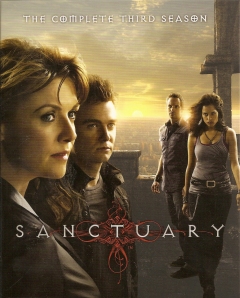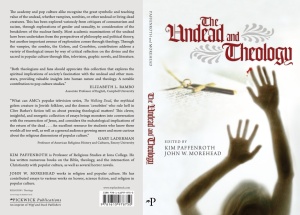UNDEAD: THE NOT-SO RESURRECTED WORLD OF MONSTERS
 The realm of the “Undead” — Vampires, werewolves, zombies, the Golem, the Homunculus. You might scratch your head. What has that stuff got to do with Resurrection? Despite the typical defensive posture that some Christians take that all of this is demonic or its just plain frivolous nonsense, the Undead in folklore, in novels, movies and TV touches many theological motifs.
The realm of the “Undead” — Vampires, werewolves, zombies, the Golem, the Homunculus. You might scratch your head. What has that stuff got to do with Resurrection? Despite the typical defensive posture that some Christians take that all of this is demonic or its just plain frivolous nonsense, the Undead in folklore, in novels, movies and TV touches many theological motifs.
Take the precredit narration of Annie the ghost who introduces herself and her two Undead flat-mates in the British TV series Being Human:
“Everyone dies. Actually, can I start that again? Everyone deserves a death. I was going to die of old age. That was the plan.
Mitchell was going to go down in a blaze of gunfire and glory. Not cold and alone and shit-scared. He didn’t think that death would smile at him first. Death was always a certainty the punchline we could all see coming. But not for Mitchell. For a vampire death isn’t the end but a beginning.
So here we are. Overlooked and forgotten. Unnatural and supernatural. Watching the dance from the sidelines. At least I was surrounded by friends and family. At least I got that bit right. You know the worst thing about being a ghost? It’s lonely. You’ll give anything for that crumb of comfort, that feel of skin upon skin that says ‘it’s ok. I’m here.’ It’s a hunger. A most basic instinct. You might even drag others into this world of the dead. Even if it means turning them into monsters too.
Then there are the ones like George. The ones that should have died. But shattered and bloody they walk away from the train wreck. But what’s the cost? They’re scarred. Transformed. They’re monsters now too. Aberrations. The stuff of nightmares. The Big Bad Wolf.
So what have we got left to look forward to? Us refugees. The flotsam and jetsam of death. Maybe if we still deserve such a thing as mercy we find each other …”
The title of the series “Being Human” encapsulates one of the big questions constantly posed by tales of the undead: what is a human being?
 Undead creatures such as vampires, zombies and werewolves were once human. Now transformed they behave in monstrous ways preying upon other humans, feeding on their blood. This feeding on the blood of the living parodies both the death of Christ and the blood motifs associated with atonement.
Undead creatures such as vampires, zombies and werewolves were once human. Now transformed they behave in monstrous ways preying upon other humans, feeding on their blood. This feeding on the blood of the living parodies both the death of Christ and the blood motifs associated with atonement.
They are usually depicted as loathsome or cursed. Lurking deep in the background of these cursed creatures is the first biblical story of a “marked” or “cursed” man: Cain. The Undead tales retain a faint echo of the implications of Cain’s story.
To be among the “Undead” signifies that these creatures are less than human. They are embodiments of evil. They are cursed because they have tried to find immortality in this life. Instead of attaining the glorification promised through Christ’s resurrection, they become a parody of the resurrection of the dead. They are a moral example with the implicit punchline: do not seek immortality in the flesh apart from God’s grace. God alone bestows resurrection.
The classic Gothic stories about the Undead and monsters have reflected the times in which the authors have lived. Stories like The Vampyre, Frankenstein, Carmilla, Dracula and The Island of Dr Moreau picked up the angst of the Industrial Revolution; the 1848 year of revolutions; human versus machine; humans in the Imago Dei or just by-products of evolution; would scientific experiments improve humanity or turn us into beasts?; was humanity inevitably progressing onwards to a golden age?
Similar issues lurk in today’s Gothic stories. Is unending life really worth having? What will humans become if the Genome is decoded? Are we destined to overcome death through technology? Will we be cyborgs? Is cloning morally dubious? Why tamper with human biology? Are humans equal to non-human animals?
These days the possibility of redemption for the Undead has also emerged. Blade has twin natures: vampire and human — recall in theology that Christ is both Divine and human. Blade stands as a quasi-Messiah figure standing between the Undead and humanity. Stephanie Meyer’s Twilight series also toys with the question can the Undead be redeemed?
The connection points between pop culture and Christians about resurrection and the Undead are just going begging.
 The steampunk TV series Sanctuary also touches on many of these same fascinating questions. The Sanctuary exists as a safe haven for all kinds of “Abnormals”, other-than-human creatures. The opening soundtrack for the series is ‘Symphonie pour un monde étrangé’, which is about a symphony for an estranged world. The soundtrack that accompanies the closing credits for series 3 and series 4 of Sanctuary features some Farsi and Latin phrases. The Latin phrases, which are not intended to convey any special meaning, are sung by the Armenian-Iraqi born female soloist Nova Emad: “fides scriptura”, “fides Christus” “fides Quarens Intellectum” (faith in Scripture, faith in Christ, faith seeking understanding). [Also refer to Disc 6 of Series 3 extra chapter “The Music of Sanctuary”]. Nevertheless the three Latin phrases that conclude Series 3 and 4 open up the vista on faith.
The steampunk TV series Sanctuary also touches on many of these same fascinating questions. The Sanctuary exists as a safe haven for all kinds of “Abnormals”, other-than-human creatures. The opening soundtrack for the series is ‘Symphonie pour un monde étrangé’, which is about a symphony for an estranged world. The soundtrack that accompanies the closing credits for series 3 and series 4 of Sanctuary features some Farsi and Latin phrases. The Latin phrases, which are not intended to convey any special meaning, are sung by the Armenian-Iraqi born female soloist Nova Emad: “fides scriptura”, “fides Christus” “fides Quarens Intellectum” (faith in Scripture, faith in Christ, faith seeking understanding). [Also refer to Disc 6 of Series 3 extra chapter “The Music of Sanctuary”]. Nevertheless the three Latin phrases that conclude Series 3 and 4 open up the vista on faith.
To find out more about resurrection and the Undead, vampire spirituality, and about resurrection and other views of the afterlife (like ghosts) check out chapters five and seven of The Cross Is Not Enough.
 We believe that much more serious theological reflection is needed about the pop cultural appeal of the Undead and Living Dead, which can extend beyond just musings about the resurrection.
We believe that much more serious theological reflection is needed about the pop cultural appeal of the Undead and Living Dead, which can extend beyond just musings about the resurrection.


